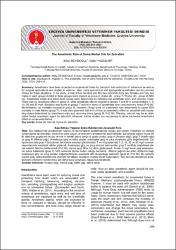| dc.contributor.author | Seyidoğlu, Nilay | |
| dc.contributor.author | Yağcılar, Çetin | |
| dc.date.accessioned | 2022-05-11T14:42:26Z | |
| dc.date.available | 2022-05-11T14:42:26Z | |
| dc.date.issued | 2020 | |
| dc.identifier.issn | 1304-7280 | |
| dc.identifier.issn | 2267-5498 | |
| dc.identifier.uri | https://doi.org/10.32707/ercivet.828319 | |
| dc.identifier.uri | https://app.trdizin.gov.tr/makale/TkRJMU1EQXhNUT09 | |
| dc.identifier.uri | https://hdl.handle.net/20.500.11776/9374 | |
| dc.description.abstract | Anesthetics have been important in ornamental fishes for transport and restriction of behaviors as well as for surgical applications and studies in science. Also, more economical and appropriate anesthetics can be common choice for these stiuations. In the study, a total of two hundred and fifty two zebrafish (forty two females and forty two males in each group) divided in three groups were studied as group A (Anise oil); group T (Thyme oil); group M (Mint oil). Anesthesia intake and lethal dose values were determined by following the anesthetic entry and recovery times. There was no anesthetic effect in group A, while anesthetic effects occured in groups T and M in concentrations 1, 5, 10, 20 and 30 mg/l. Similarity was found in groups T and M in terms of anesthesia entry and recovery times (P>0.05). Nevertheless, no mortality occured in group M. However, 5mg/l tyme oil anesthesia was determined to cause 50% mortality in male fishes (group T). It was also observed that mint oil has an anesthetic effect on zebrafish with increa-sing doses determined by anesthesia entry and recorvery times (group M, P<0.05). Thereby, mint oil may be an alter-native herbal anesthetic agent for zebrafish. However, further studies are neccessary to show the herbal anesthetics effect on ornamental fishes. | en_US |
| dc.description.abstract | Süs balıklarında anestezikler, taşıma ve davranışların azaltılmasında olduğu gibi cerrahi müdahale ve bilimsel çalışmalarda da önemlidir. Genellikle daha uygun ve ekonomik anestezikler seçilmektedir. Çalışmada toplam ikiyüz elli iki adet (her grupta kırk iki dişi ve kırk iki erkek) zebra balığı üç gruba ayrıldı; grup A (Anason yağı), grup T (Kekik yağı) ve grup M (Mentol yağı). Anesteziye giriş ve lethal dozlar, anesteziye giriş ve çıkış sürelerine göre değerlendirildi. Ça-lışma sonunda grup A’da bulunan balıklarda anestezi görülmezken T ve M gruplarında 1, 5, 10, 20 ve 30 mg/l konsant-rasyonlarında anestezik etkiler gözlendi. Anesteziye giriş ve çıkış süreleri bakımından grup T ve M’de istatistiksel ola-rak anlamlı farklılık belirlenmedi (P>0.05). Ayrıca grup M’de hiç ölüm gözlenmedi. Ancak, 5 mg/l kekik yağı anestezisi-nin erkek balıklarda (grup T) %50 oranında ölüme neden olduğu belirlendi. Mentol yağının ise artan dozlarına bağlı anesteziye giriş ve çıkış süreleri değerlendirilerek anestezik etki oluşturduğu belirlendi (grup M, P<0.05). Bu nedenle mentol yağı, zebra balıklarında alternatif bir bitkisel anestezik madde olarak kullanılabilir. Süs balıklarında bitkisel anes-teziklerin etkilerinin belirlenmesi için daha fazla çalışmaya ihtiyaç bulunmaktadır. | en_US |
| dc.language.iso | eng | en_US |
| dc.identifier.doi | 10.32707/ercivet.828319 | |
| dc.rights | info:eu-repo/semantics/openAccess | en_US |
| dc.title | The Anesthetic Role of Some Herbal Oils for Zebrafish | en_US |
| dc.title.alternative | Bazı Bitkisel Yağların Zebra Balıklarında Anestezik Rolü | en_US |
| dc.type | article | en_US |
| dc.relation.ispartof | Erciyes Üniversitesi Veteriner Fakültesi Dergisi | en_US |
| dc.department | Fakülteler, Veteriner Fakültesi, Temel Bilimler Bölümü, Fizyoloji Ana Bilim Dalı | en_US |
| dc.identifier.volume | 17 | en_US |
| dc.identifier.issue | 3 | en_US |
| dc.identifier.startpage | 209 | en_US |
| dc.identifier.endpage | 214 | en_US |
| dc.institutionauthor | Seyidoğlu, Nilay | |
| dc.identifier.trdizinid | TkRJMU1EQXhNUT09 | en_US |



















